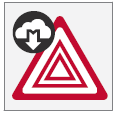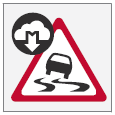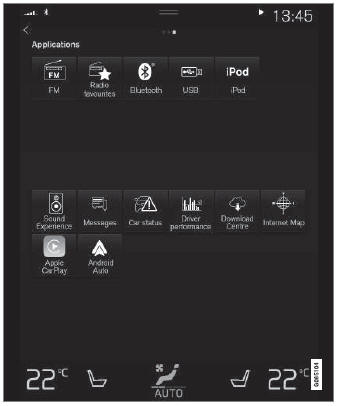Volvo XC90: Driver support / Connected Safety
(Not available in all markets.)
Connected Safety communicates information between your vehicle and other vehicles via the Internet1. The function is designed to notify the driver of any hazardous road conditions ahead.
The function can notify the driver if another vehicle further down the road has activated its hazard warning flashers or detected slippery road conditions. You will also be notified if your own vehicle detects slippery road conditions.
Connected Safety can assist the driver with the following:
- Hazard warning flashers alert
- Slippery road alerts
Connected Safety communication between vehicles only works for vehicles that are equipped with the function and have it activated.
Hazard warning flashers alert
If your vehicle's hazard warning flashers are activated, information on this can be sent to other vehicles approaching your location.
 When your vehicle approaches a vehicle
with its hazard warning flashers on, this symbol will appear in the instrument panel.
When your vehicle approaches a vehicle
with its hazard warning flashers on, this symbol will appear in the instrument panel.
In vehicles equipped with a head-up display, the warning symbols for Connected Safety will also be displayed there.
Slippery road alerts
If your own car detects reduced friction between your tires and the road, information on this can be sent to vehicles approaching your own car's position.
 As the vehicle approaches the area
affected, this symbol will be displayed in the instrument panel to alert the driver
of slippery road conditions. Drivers of other vehicles receiving information via
Connected Safety will receive similar notifications as they approach the area.
As the vehicle approaches the area
affected, this symbol will be displayed in the instrument panel to alert the driver
of slippery road conditions. Drivers of other vehicles receiving information via
Connected Safety will receive similar notifications as they approach the area.
In vehicles equipped with a head-up display, the warning symbols for Connected Safety will also be displayed there.
WARNING
- The function is supplementary driver support intended to facilitate driving and help make it safer – it cannot handle all situations in all traffic, weather and road conditions.
- The driver is advised to read all sections in the Owner's Manual about this function to learn of its limitations, which the driver must be aware of before using the function.
- Driver support functions are not a substitute for the driver's attention and judgment. The driver is always responsible for ensuring the vehicle is driven in a safe manner, at the appropriate speed, with an appropriate distance to other vehicles, and in accordance with current traffic rules and regulations.
1 There may be a charge for transmitting data over the Internet, depending on your service plan.
 Electronic Stability Control symbols and messages
Electronic Stability Control symbols and messages
A number of symbols and messages related to Electronic Stability Control (ESC1)
may be displayed in the instrument panel. Several examples are provided below...
 Activating or deactivating Connected Safety
Activating or deactivating Connected Safety
For Connected Safety to be able to share information about road conditions
with other drivers, the function must be activated. If you do not wish to share
information, the function can be deactivated...
Other information:
Volvo XC90 2015-2025 Owners Manual: Driving with the Start/Stop function
Start/stop is a function that temporarily turns off the engine when the vehicle is stationary and then automatically starts it when needed. The Start/Stop function is available when the ignition is started and can be activated if certain conditions are met...
Volvo XC90 2015-2025 Owners Manual: Occupant weight sensor
The Occupant Weight Sensor (OWS) is designed to meet the regulatory requirements of Federal Motor Vehicle Safety Standard (FMVSS) 208 and is designed to disable (will not inflate) the passenger's side front airbag under certain conditions. Occupant Weight Sensor (OWS) indicator light Disabling the passenger's side front airbag Volvo recommends that ALL occupants (adults and children) shorter th..

